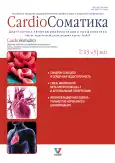Антрациклин-индуцированная кардиомиопатия в отдалённом периоде после химиотерапии: клинический случай
- Авторы: Козявин Н.А.1, Мурейко Е.А.1, Никифоров В.С.2, Беляев А.М.1
-
Учреждения:
- ФГБУ «НМИЦ онкологии им. Н.Н. Петрова» Минздрава России
- ФГБОУ ВО «Северо-Западный государственный медицинский университет им. И.И. Мечникова» Минздрава России
- Выпуск: Том 13, № 3 (2022)
- Страницы: 176-180
- Раздел: Клинические случаи
- URL: https://journals.rcsi.science/2221-7185/article/view/134175
- DOI: https://doi.org/10.17816/CS133645
- ID: 134175
Цитировать
Полный текст
Аннотация
Обоснование. Как известно, лечение онкологического процесса приводит либо к возникновению сердечно-сосудистой патологии, либо к увеличению риска развития смерти от сердечно-сосудистых заболеваний. В настоящее время введено понятие «кардиоваскулярная токсичность», которое связано с лечением онкологического заболевания (CTR-CVT). Системная лекарственная антрациклин-содержащая противоопухолевая терапия может вызвать ряд кардиоваскулярных осложнений, таких как систолическая дисфункция миокарда, ишемическая болезнь сердца, нарушения сердечного ритма, артериальная гипертензия. Особое внимание уделяют препаратам антрациклинового ряда, ведь они до сих пор входят в комбинации многих режимов адъювантной терапии и первой линии лечения как наиболее распространённых онкологических заболеваний, так и более редких.
Описание клинического случая. В статье представлен клинический случай пациентки, получившей адъювантную полихимиотерапию по поводу рака молочной железы в 2017 году режимом AC ×4 →D ×4, у которой спустя годы после завершения противоопухолевой терапии манифестировала хроническая антрациклин-индуцированная кардиомиопатия. Развитие антрациклиновой кардиомиопатии возможно даже у пациентов, имеющих исходно низкий кардиологический риск.
Заключение. Клинический случай подчёркивает важность наблюдения за пациентами после окончания противоопухолевой терапии антрациклинами, в частности им показано периодическое выполнение эхокардиографического исследования с целью обнаружения отсроченной бессимптомной дисфункции миокарда.
Полный текст
Открыть статью на сайте журналаОб авторах
Никита Александрович Козявин
ФГБУ «НМИЦ онкологии им. Н.Н. Петрова» Минздрава России
Email: kozjavin-nikita@mail.ru
ORCID iD: 0000-0003-2759-4817
зав. КДЦ ФГБУ НМИЦ онкологии
Россия, 191015, Санкт-Петербург, ул. Кирочная, д. 41Екатерина Андреевна Мурейко
ФГБУ «НМИЦ онкологии им. Н.Н. Петрова» Минздрава России
Email: emureyko@mail.ru
ORCID iD: 0000-0003-1626-082X
SPIN-код: 2023-1598
врач-ординатор
Россия, 191015, Санкт-Петербург, ул. Кирочная, д. 41Виктор Сергеевич Никифоров
ФГБОУ ВО «Северо-Западный государственный медицинский университет им. И.И. Мечникова» Минздрава России
Email: victor-nikiforov@yandex.ru
ORCID iD: 0000-0001-7862-0937
SPIN-код: 4652-0981
д-р мед. наук, проф. каф. функциональной диагностики, декан
Россия, 191015, Санкт-Петербург, ул. Кирочная, д. 41Алексей Михайлович Беляев
ФГБУ «НМИЦ онкологии им. Н.Н. Петрова» Минздрава России
Автор, ответственный за переписку.
Email: bam281060@yandex.ru
ORCID iD: 0000-0001-6588-1257
SPIN-код: 9445-9473
д-р мед. наук, проф., дир., зав. каф. онкологии СЗГМУ им. И.И. Мечникова, председатель Ассоциации онкологов Северо-Запада
Россия, 191015, Санкт-Петербург, ул. Кирочная, д. 41Список литературы
- Pudil R, Mueller C, Celutkiene J, et al. Role of serum biomarkers in cancer patients receiving cardiotoxic cancer therapies: a position statement from the Cardio-Oncology Study Group of the Heart Failure Association and the Cardio-Oncology Council of the European Society of Cardiology. Eur J Heart Fail. 2020;22(11):1966–1983. doi: 10.1002/ejhf.2017
- Сelutkienе J. Pudil R, López-Fernández T, et al. Role of cardiovascular imaging in cancer patients receiving cardiotoxic therapies: a position statement on behalf of the Heart Failure Association (HFA), the European Association of Cardiovascular Imaging (EACVI) and the Cardio-Oncology Council of the European Society of Cardiology (ESC). Eur J Heart Fail. 2020;22(9):1504–1524. doi: 10.1002/ejhf.1957
- Vitsenya MV, Ageev FT, Gilyarov MYu, et al. Practical recommendations for the correction of cardiovascular toxicity of anticancer drug therapy. Malignant tumors. 2019;9(3S2):609–627. (In Russ). doi: 10.18027 / 2224-5057-2019-9-3s2-609-627
- McDonagh TA, Metra M, Adamo M, et al. 2021 ESC Guidelines for the diagnosis and treatment of acute and chronic heart failure. Eur Heart J. 2021;42(36):3599–3726. doi: 10.1093/eurheartj/ehab368
- Cardinale D, Biasillo G, Salvatici M, et al. Using biomarkers to predict and to prevent cardiotoxicity of cancer therapy. Expert Rev Mol Diagn. 2017;17(3):245–256. doi: 10.1080/14737159.2017.1283219
- Chen MH, Colan SD, Diller L. Cardiovascular disease: cause of morbidity and mortality in adult survivors of childhood cancers. Circ Res. 2011;108(5):619–628. doi: 10.1161/CIRCRESAHA.110.224519
- Mann D, Felker G. Heart Failure: A Companion to Braunwald’s Heart Disease. 4th ed. Philadelphia: Elsevier; 2016.
- Cardinale D, Colombo A, Bacchiani G, et al. Early detection of anthracycline cardiotoxicity and improvement with heart failure therapy. Circulation. 2015;131(22):1981–1988. doi: 10.1161/CIRCULATIONAHA.114.013777
- Ryberg M, Nielsen D, Cortese G, et al. New insight into epirubicin cardiac toxicity: competing risks analysis of 1097 breast cancer patients. J Natl Cancer Inst. 2008;100(15):1058–1067. doi: 10.1093/jnci/djn206
- Chazova IE, Ageev FT, Aksenova AV, et al. Eurasian clinical guidelines for cardiovascular complications of cancer treatments: diagnosis, prevention and treatment (2022). Eurasian heart journal. 2022;(1):6–79. (In Russ). doi: 10.38109/2225-1685-2022-1-6-79
Дополнительные файлы










